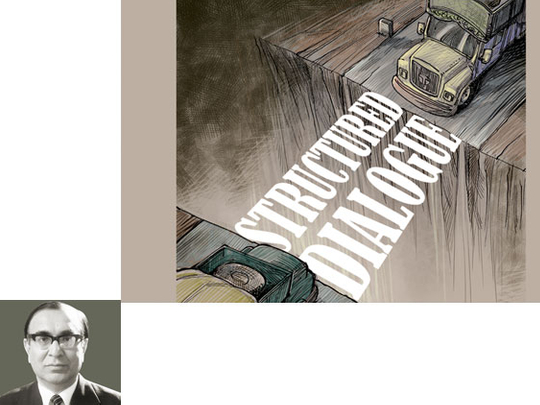
Pakistan President Asif Ali Zardari and India’s Prime Minister Dr Manmohan Singh took the opportunity of meeting on the sidelines of the Non-Aligned Movement (NAM) Summit in Tehran, a tradition that the two states have maintained in good times and bad.
This comes a few weeks after Zardari visited the shrine of a Muslim saint at Ajmer Sharif in India and went to New Delhi to review entangled bilateral relations with Dr Singh. In Delhi, he renewed the oft-extended invitation to the Indian leader to visit Pakistan and followed it up with a notably warm letter of invitation.
Meanwhile the ‘structured dialogue’ (once known as ‘composite dialogue’) has virtually completed a full round for the first time after the suspension of meetings in the wake of the 26/11 Mumbai attacks in 2008.
This particular process conducted at the level of officials concerned with the detailed agenda items in dedicated committees will attain its political high-water mark on September 7 when India’s Foreign Minister S.M. Krishna visits Islamabad.
The official dialogue was mostly a case of deja vu as it produced nothing more than the old ritual of restating known positions with signs of a real thaw only in creating an environment for considerably enhanced bilateral trade. The peace constituencies in India and Pakistan have traditionally looked to the top leadership to carve out pathways by which the all-too-familiar hurdles can be circumvented and the peace process energised.
Following the ‘Ajmer Sharif summit’, there was optimism that the next conversation between Zardari and Dr Singh during the NAM Summit would be marked by an announcement that the latter had finally decided to honour the Pakistani invitation and that November would see the much-needed intervention by the highest leaders in the peace talks otherwise destined to move forward at a glacial pace.
To much disappointment in Pakistan, this was not to be; Dr Singh repeated his earlier demand that Pakistan should first create an appropriate atmosphere for his visit — a coded phrase for Indian expectations that Pakistan punish the individuals named by India as complicit in the Mumbai tragedy.
Even a casual student of the Pakistani judicial scene — the Supreme Court of Pakistan’s decision in a case concerning Zardari led to the unceremonious departure of an elected prime minister while his successor is on notice to fulfil the court’s orders that the outgoing prime minister had wilfully defied — would know that the Pakistani government does not have the means to quicken the legal proceedings against the suspects named by India.
The post-Tehran feeling in Pakistan is that progress on trade will continue even if Dr Singh does not visit in November. But the quest for a comprehensive rapprochement that Pakistan hopes for will remain hostage to hardliners in India as Dr Singh is simply not strong enough to override their negative stance and give, jointly with Zardari, a strategic new direction.
Worse, fears have re-emerged that the differences on what should be mutually accepted objectives underpinning an across-the-board reconciliation and the contingent negotiating postures have not been bridged. In plain English, India does not share Pakistan’s sense of urgency in reaching that imagined destination.
These apprehensions are substantiated in the Pakistani eye by the fact that the ‘structured dialogue’ has revealed a certain hardening of Indian positions, particularly on two issues — disengagement of troops in the dizzy heights of Siachen and conclusion of the project to demarcate a border in Sir Creek in the Rann of Kutch area on the western coast.
Pakistani negotiators have more or less concluded that the Indian army has come to exercise a veto on the Siachen issue. On Sir Creek, where a state-of the art scientific survey has eliminated ambiguities about facts on the ground, India has reportedly stalled an agreement by insisting on “first drawing the maritime boundary in the middle of the estuary and the land boundary later”.
Optimism about building up trade endures and Krishna’s visit may give a fillip to it if the two sides finally sign an agreement for a more liberal visa regime. There is some progress on improving infra-structure that would help bring within the ambit of official trade considerable smuggling and far more costly trade through third countries.
Pakistan is still waiting for Indian action to dismantle some of its more constraining non-tariff barriers. Nevertheless, a great opportunity now exists to triple the existing official trade of $2.6 billion.
There would still be a large untapped potential but that may come to depend on progress in other sectors without which Pakistan may find it extremely difficult to fulfil Indian expectations of overland transit through Pakistan to Afghanistan.
The redeeming feature of the current situation is that notwithstanding vociferous opposition to reconciliation in some quarters, the direction is positive and may even be irreversible. It seems that the people will not easily support a return to the era of frequent and doubtless futile, confrontations.
Tanvir Ahmad Khan is a former ambassador and foreign secretary of Pakistan









